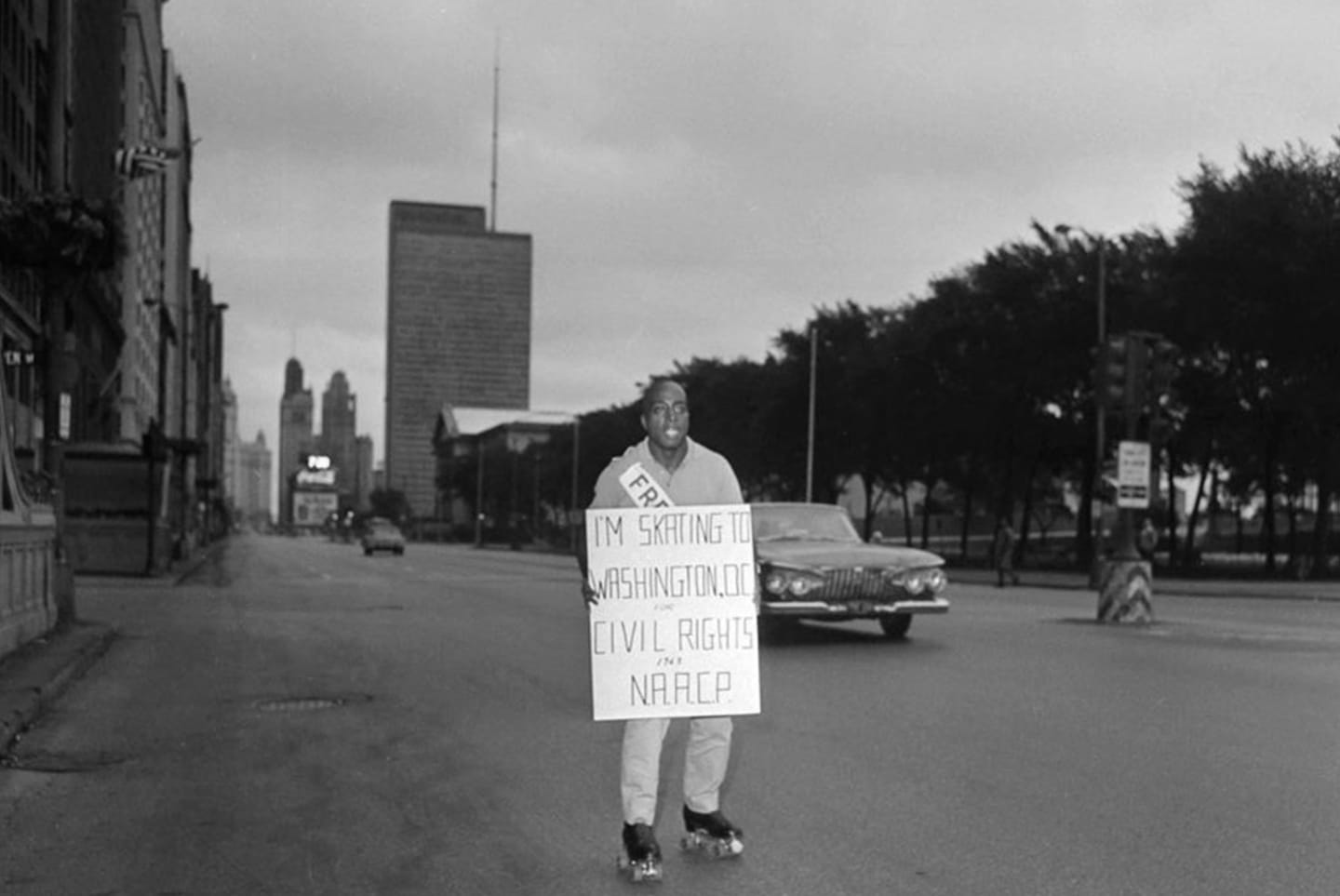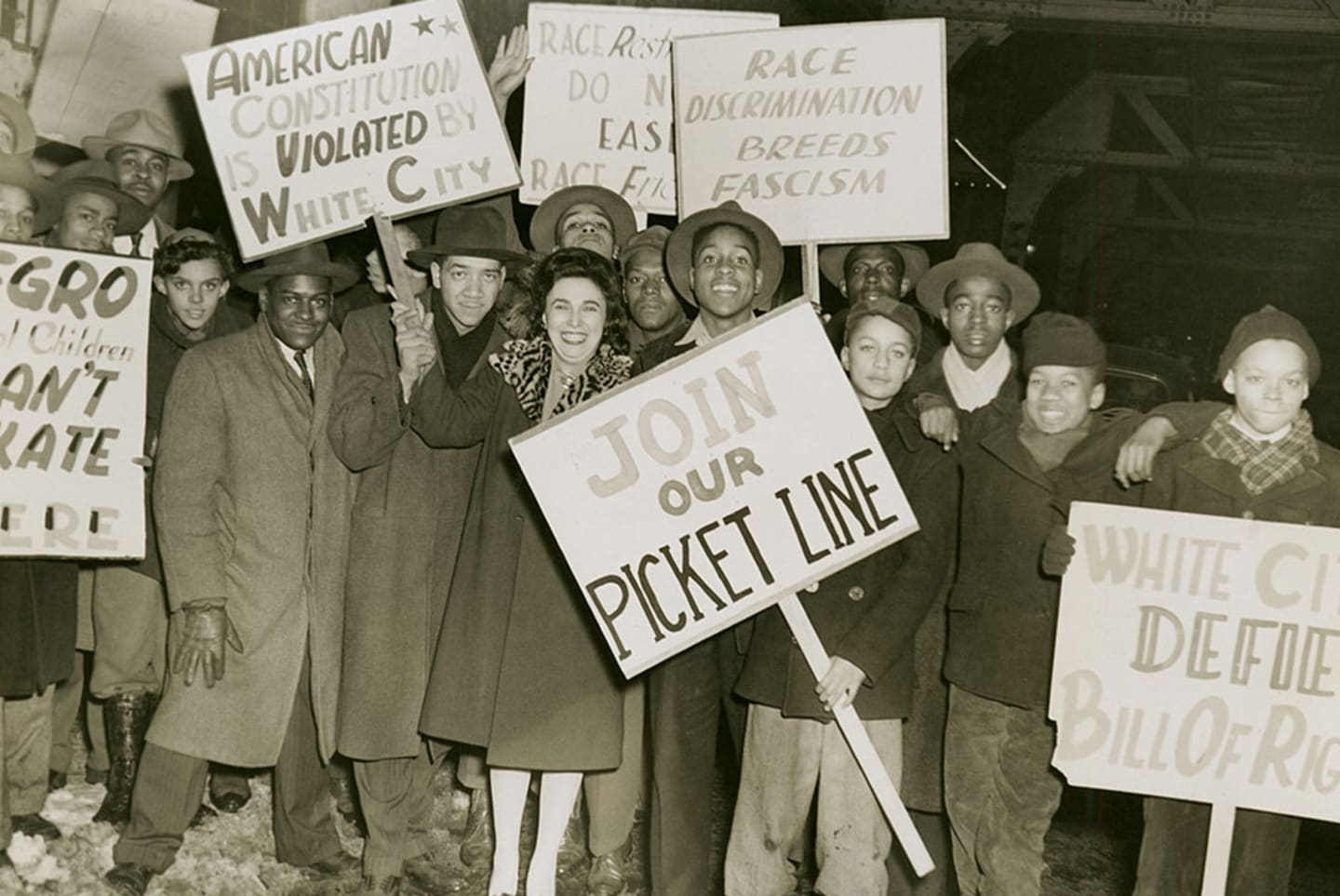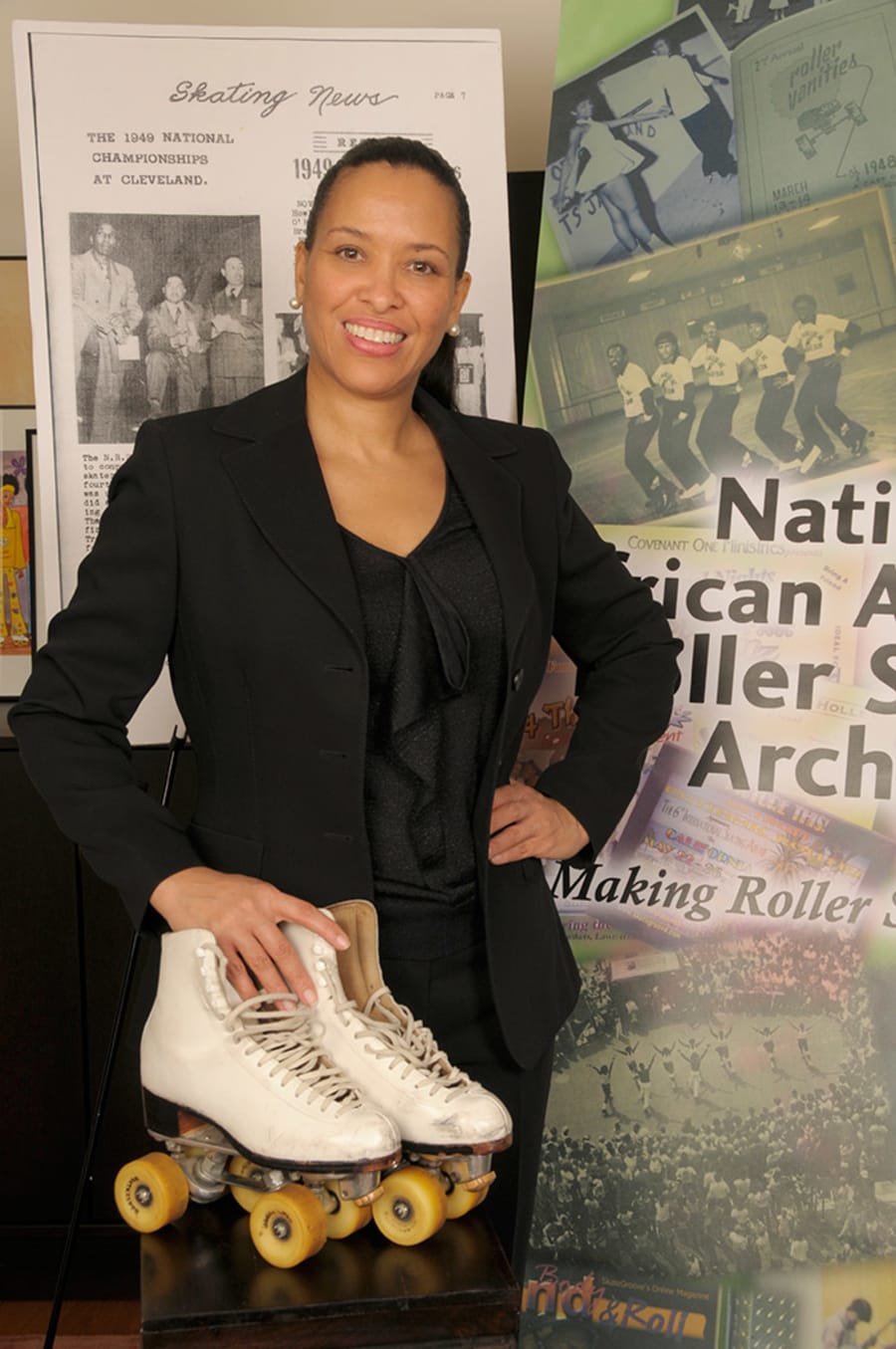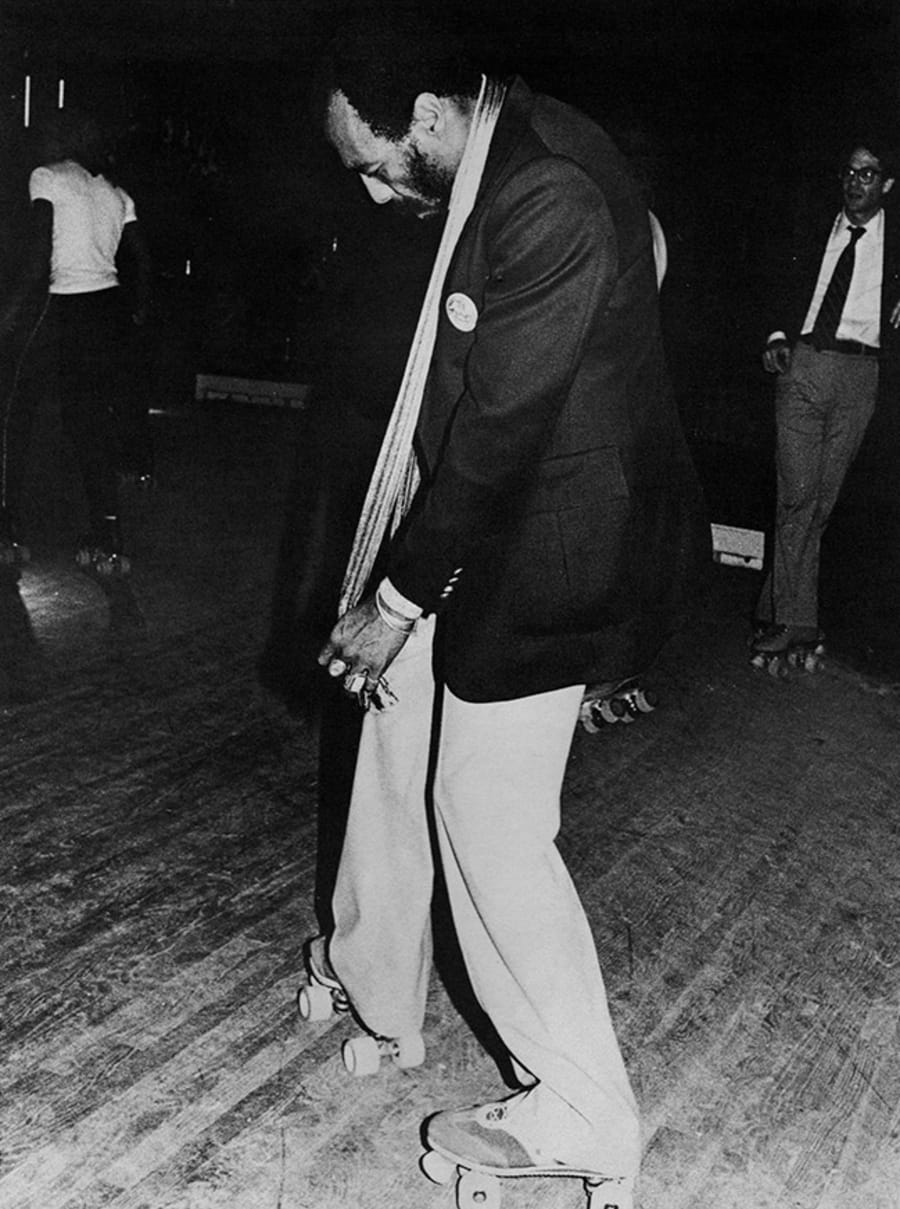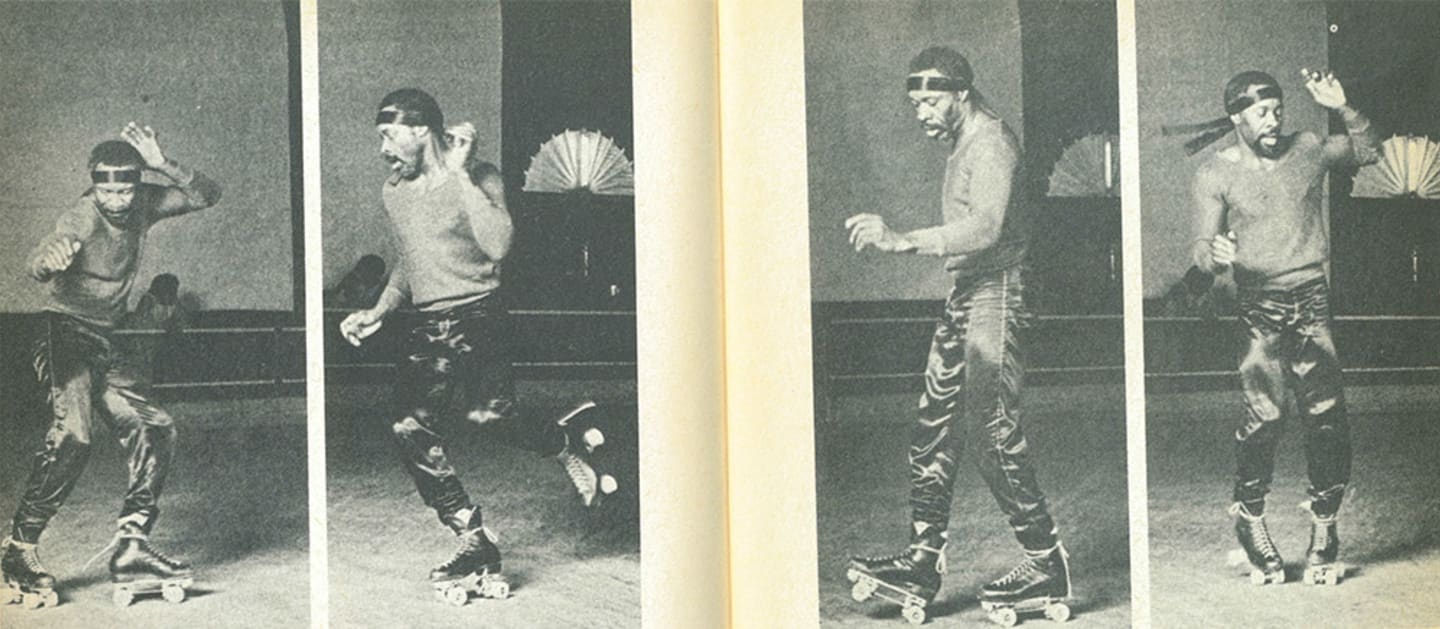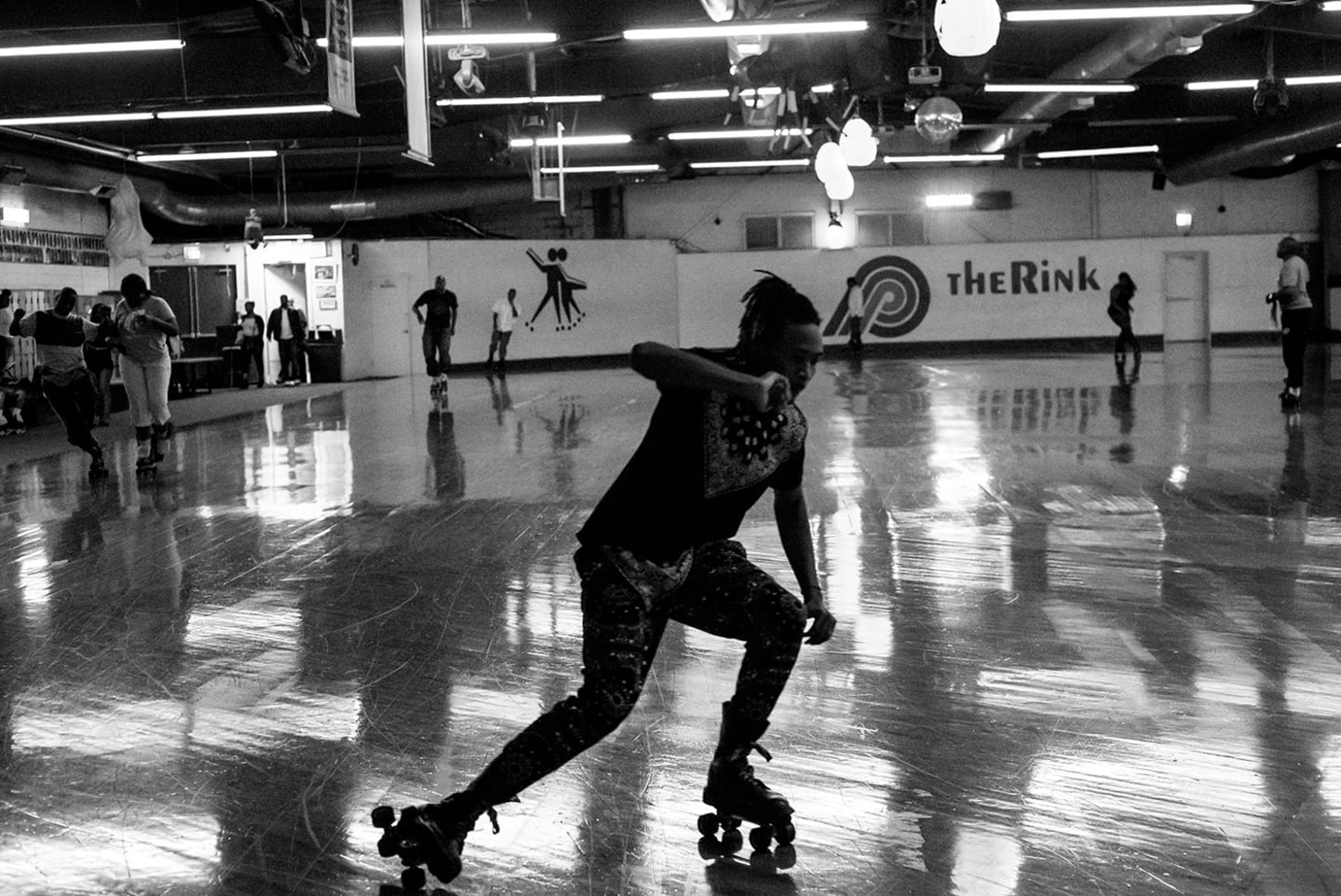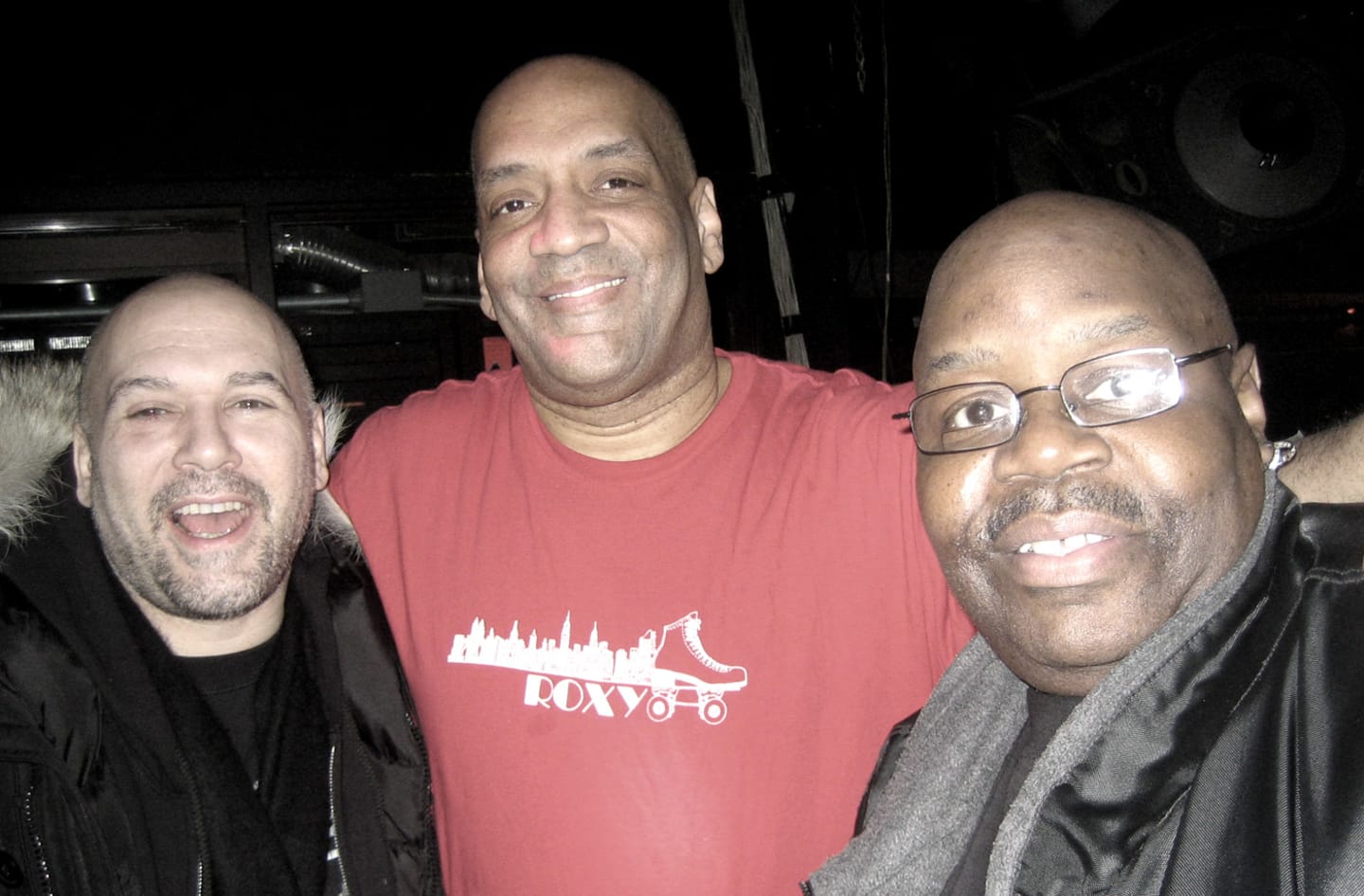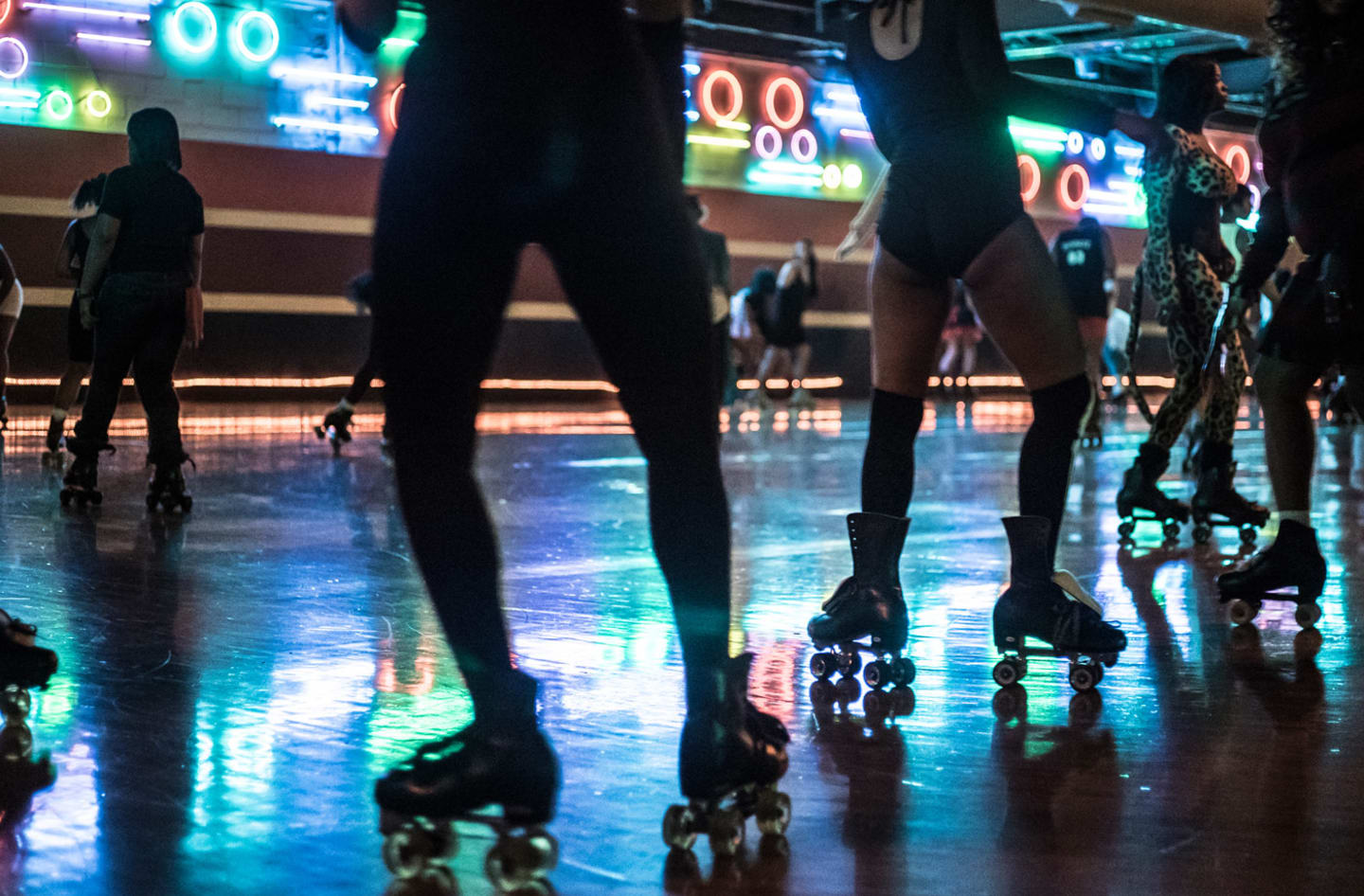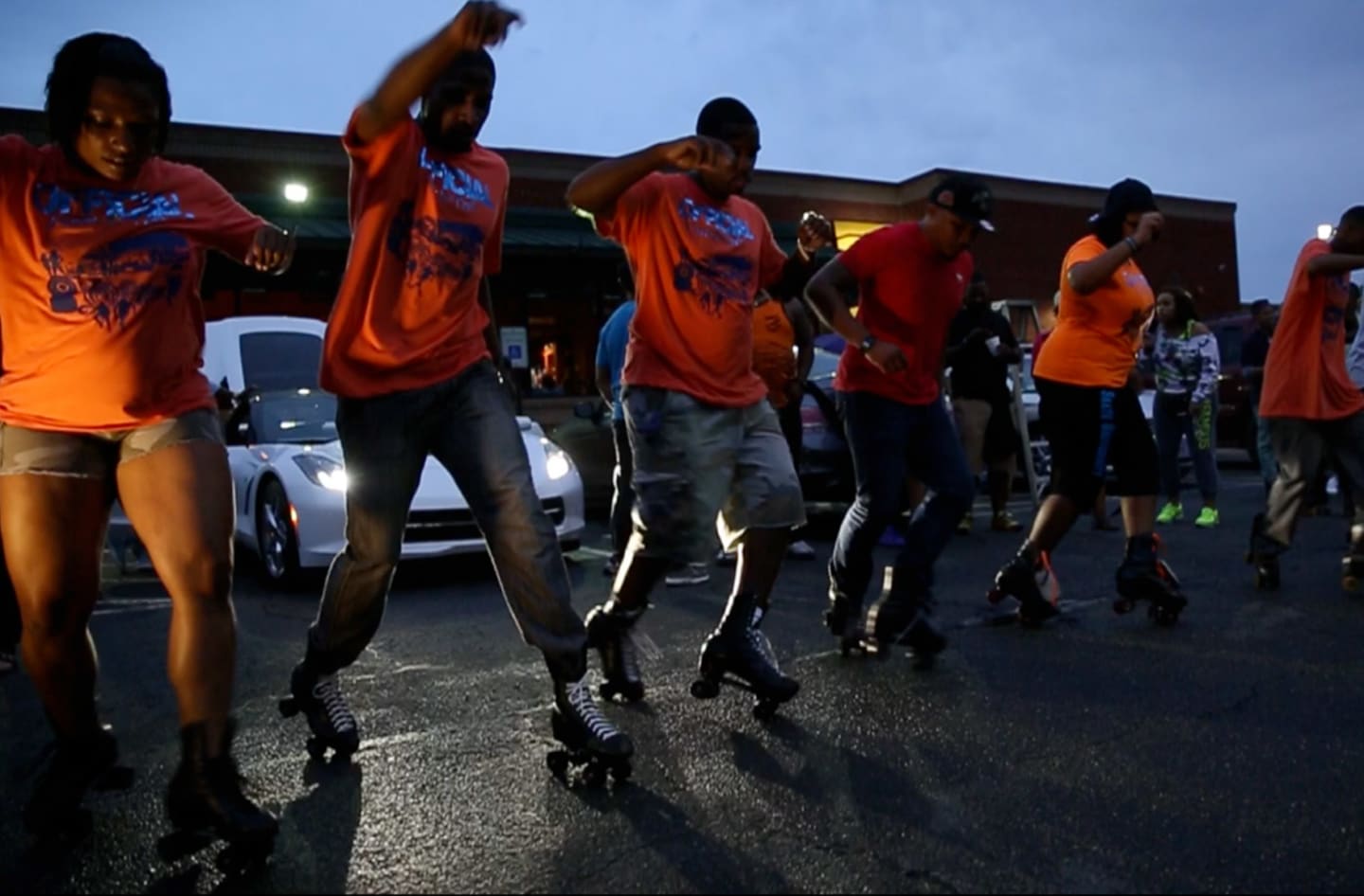Roller Skating, Civil Rights, and the Wheels Behind Dance Music
This archival feature from Electronic Beats, initially published in 2014, explores rollerskating culture and its relationship to dance music evolution in Chicago and New York City.
Wheels matter for music. From roller skating grooves and the importance of punk, hardcore, and hip-hop for skateboarding to productions tailored specifically to car audio bass—the feeling of freedom that movement from wheels provides has long permeated pop-cultural consciousness.
In the beginning, there was a loop. The history of modern roller skating and its relationship to dance music is one of direction, flow, and repetition: on the most micro level, wheels turn, allowing pivots and limbs to swerve and sway. Zooming out farther, skaters cruise at rinks counter-clockwise in an oval, over and over again, lost in rhythm but always gliding in time to an all-powerful groove laid down by the DJ. However, skating isn’t just defined by a smoothness dictated by the DJ’s predominantly groove- and loop-based music—it has long fed back into the production of dance music that’s as popular outside of the rink as inside.
And yet, within the broader pop-cultural narrative, roller skating, like disco, still receives short shrift as a fad that went out of style with pet rocks. That is, predominantly for white communities. Because roller skating in the United States—specifically “style” skating—has long been a Black American past time. And unbeknownst to most of white America, where roller rinks have long closed down or are used predominantly for “artistic” breakdance and figure skating-like competitions, skate culture in Black communities continues to be as popular today as it ever was. Yet its influence on the development of dance music, from disco, funk, and R&B, to hip-hop, crunk, Miami bass, techno, and later on, footwork, has long gone criminally underdocumented—a glaring omission also reflected in the larger context of academic roller skating histories. In short, skating has been vital to both the evolution of popular American dance and dance music for decades. And to understand why is to understand the remarkable space that it occupies at the very core of American civil rights struggles.
But first, a brief history. In the forties and fifties, roller rinks, like swimming pools, amusement parks, and other spaces of recreation in America, were strongholds of de facto segregation in the North, where the second phase of large scale African American migration from the South had recently come to a close. But unlike the then newly implemented integration of the labor force and the U.S. military, which were guided by the pragmatic color-blindness of American capitalism and militarism, skating rinks were amongst the last bastions of social “leisure” spaces separating white from Black. As historian Victoria Wolcott explains in her singular work connecting roller skating and civil rights history, Race, Riots, and Roller Coasters: The Struggle over Segregated Recreation in America, co-ed dance and music culture at roller rinks ultimately provoked widespread fear of interracial sexuality: “In sites where leisure was consumed actively and men and women mixed, segregation invariably followed.” This intensified when, at the same time, the introduction of vinyl and the accessibility of record players revolutionized the music that was played in rinks.
In cities like Chicago and Detroit, gaudy tones of the Wurlitzer organ—the familiar hurdy-gurdy-like sound of American amusement—were replaced by early R&B à la Jimmy Forrest, Count Basie, or Duke Ellington. Suddenly, quad skates—an innovation from the original nineteenth-century inline skate design—were being used to their full potential as tools of dance to early groove and swing-based music in African American skate communities. But “Black” skate nights weren’t simply provided by white rink owners in the forties; they were hard-won through civil disobedience. Many of the first sit-ins in America protesting racial inequality were actually “skate-ins,” which took place across the northern United States a good twenty years before the mass mobilization of marchers fighting legal segregation in the South. These included the violent White City Roller Rink protests in Chicago, as well as NAACP-led rallies at the Alhambra Roller Skating Rink in Syracuse, New York, and at Harriet Island Park in St. Paul, Minnesota, amongst numerous others. And while rinks everywhere were transformed into battlegrounds in the fight for equal rights, the result, paradoxically, was often not the integration ideal, with black and white skaters gliding to a new rhythm together, but rather exclusively “Black” nights and “white” nights; or alternately, exclusively “Black” rinks, albeit often with white owners—a phenomenon that persists to this day, much to the chagrin of the African American skate community, and key figures like skate historian Tasha Klusmann.
Klusmann, a Washington D.C. native, runs the National African American Roller Skating Archive, housed at the prestigious Howard University, which boasts hundreds of interviews with style skaters and DJs. For her, African American culture is as integral a part of roller skating history as skate history is to African American culture—a position largely ignored by historians of both. Today’s African American style skating communities across the U.S. still regularly experience difficulty in finding rinks to host larger late night “adult” parties—an obvious vestige of a historical struggle. This is also reflected in the usurpation of dance moves pioneered in black skate communities by “jam” skaters celebrated in predominantly white mainstream skate circles. For Klusmann, music and skate style are two sides of the same coin, developed in tandem with the introduction of soul, R&B, funk, and early disco into the rinks. But the marked regional differences in music played in the rinks across the country, from the fifties up through the eighties, were partially a result of the fight for independent African American radio for- mats—that is, in contrast to today’s nationalized generic music conglomerates that control the airwaves.
As she put it, “When I was a teenager, we didn’t have national radio. There were local D.C. radio stations only, so what music we liked might not have been what was going on in Detroit and New York and anyplace else. Every hub had the music it liked, and this was really the case with the black community. For D.C. in the seventies, it was Melvin Lindsey’s original Quiet Storm show on Howard University radio WHUR-FM.” With a few exceptions, notably Amy Reinink’s excellent writing on the D.C. skate scene, and a promising upcoming documentary United Skates by Dyana Winkler and Tina Brown, which focuses more on African American skate culture at large, little has been done on the significant influence of skate culture on dance music.
Ultimately, countless rinks in African American neighborhoods have functioned as veritable petri dishes for the regional development of dance music cultures and were often equipped with separate dancefloors (occasionally “kiddy” discos), where young performers would get their first break, and budding DJs could expand their repertoire on top of playing for the skaters. This story and the following interviews should by no means be considered an exhaustive account of the music inspired by and played for skating’s smooth glide within the rinks’ larger loop. It also shouldn’t be considered a detailed account of the relationship between race, segregation, and style skating. Those each deserve separate books and would have to include cities like Los Angeles, Atlanta, Houston, and St. Louis (amongst others), all of which have big skate scenes and notable musicians born from them.
Nor is the emphasis here on the act of skating or the vibrant scene itself. Instead, this is about the historical foundations of influential dance music sub-cultures. The interviews here are, barring a few notable exceptions, with DJs and producers whose reach in dance music has gone beyond that of the rink to be able to explain the music’s influence outside of it. Here in Part One, the focus will be New York’s original disco and boogie powered style skate explosion and a brief introduction to the birth of the hip-hop groove, as well as Chicago’s reworkings of James Brown and the fever-pitched footwork that developed alongside of it.
New York City – Disco, Boogie, and Beyond: Danny Krivit
It goes without saying that in dance music history, it doesn’t get much more fertile an environment than New York in the late seventies and early eighties, from which disco, house, and hip-hop would emerge. Empire Roller Rink in Brooklyn is often credited as the nucleus of the funkier, bass-driven skate styles. DJs such as the legendary Robert “Big Bob” Clayton—still an active selector on the national roller skating scene—introduced a disco vibe that matched the utterly original moves previously introduced to the rink by the godfather of style skating, Detroit native Bill Butler. As Butler explained to me recently by telephone from Atlanta, the true revolution in skating at Empire came with his own insistence on introducing the slow groove of Count Basie’s “Night Train” to Empire’s then-primitive sound system in the fifties: “In Detroit, we had to picket to skate a single night because it was an especially segregated city at the time. Then I landed in Brooklyn in 1957 and changed the whole concept of roller skating by introducing Count Basie. Everything after that became skating to the downbeat, and the rest is history. See, space plus the beat equals all strides. I could have been a mechanical engineer, but I chose to roller skate.”
While Butler would go on to develop many of the strides and dance moves that became de rigueur for style skaters in the disco era (documented according to the region in his famous how-to-style skating book Jammin’), Manhattan’s Roxy roller rink would prove to be equally influential in terms of its selectors, amongst whom dance music pioneers DJ Julio and Danny Krivit stood out. Krivit, a DJ, producer, and founder of the legendary 718 Sessions party in New York, sees an enormous and often undiscussed influence of New York’s groove-based skate music styles on much of the disco and post-disco tracks made in the seventies and eighties. As a native New Yorker and a busboy in his father’s legendary West Village cafe, The Ninth Circle, Krivit grew up surrounded by music and musicians who defined various eras in popular music, from childhood friend Nile Rodgers of Chic and neighbor Ian Underwood of The Mothers of Invention to meetings with James Brown. Here, Krivit takes us through style skating’s most defining era in New York dance music:
I roller skated when I was a kid with little metal skates. It was just an activity like any other.
“I certainly didn’t think of going to a roller skating rink, even though they did exist, because at the time rinks that I knew of only played muzak and melodies. It was not rhythm, and certainly nothing with a beat. The rinks back then didn’t encourage that. And ethnic or ‘non-white’ rinks were pretty segregated. But this started to change in the seventies in New York, which is also when certain rinks started to play entirely different music than before. Ultimately, the real change in skating came from when people stopped skating to melody and started skating to the groove. For me, at the center of this was Bill Butler and DJs like Big Bob at the Empire Roller Rink in Brooklyn in the mid-seventies. Around the same time I got my first more serious pair of three hundred dollar skates. Suddenly I could control how I moved, even dance on skates. By ’77 I started seeing that there was a whole skating scene. Then, in the summer of ’79, I DJ’d an outdoor skating party, which is where I met DJ Julio, with whom I would come to DJ with at The Roxy. That was the first time I played just for skaters.
Disco had gotten very strong towards the end of the seventies, but the music also seemed to get a bit whiter and more about the beat than the groove. Even though my style was more soulful and funky and perfect for roller skating, it had me kind of not in the disco trend. I wasn’t playing “Born To Be Alive” but rather B.T. Express. When I played the roller skating gig, it was suddenly much more groove-oriented, much more what I was actually into. And for my mixing style, the skating was also teaching me something: It wasn’t about mixing things only beat on beat, it was more about mixing in the groove. And it was also more downtempo, not as frantic, and not choppy. When I got the opportunity to audition at The Roxy in December 1979, I didn’t think I had much chance of getting the job. I was competing against a lot of the city’s top DJs. But The Roxy was such a huge rink, with the DJ booth way at the far end, and they didn’t have any monitors for the audition, so when you were trying to mix, there was this huge delay and echo on the beat. A lot of the DJs weren’t prepared for that and ended up doing train wreck mixes and also played a lot of inappropriate stuff.
So when I came on, you can see from the things that were in my chart from the same month, like Shalamar, Prince, and Trussel, that I was playing skaters jams. I also knew this element of record store style mixing, which was bringing something in at a very low volume and correcting it on the first or second beat before anyone else really hears anything wrong, and then bringing up the volume and completing the mix correctly. The owner of Roxy, Steven Greenberg, told me I was the main DJ Julio, who was an established roller skating DJ already at the Metropolis, was also in.
Steven was not an easy person to work for, but I made it through to the next owner, also named Steve, who owned another slightly larger rink in Long Island called Laces, where I also got a job and remained there as their main DJ for ten years. Some weeks I’d DJ seven nights a week, but I always played for skaters at least two nights a week. It was a very different scene than club music, but the roller skating groove seemed very natural to me and grounded me musically. The end of 1979 was the height of the “disco sucks” period. Around the same time I started to play at Roxy for skaters, most clubs were fleeing from disco, but they didn’t know what to replace it with. New wave was the first replacement choice, but it didn’t really stick. Then there was freestyle, and eventually, people thought, “Maybe we can get into rap,” but it was still too early for that. That’s about when house music slipped in, kind of a raw stripped-down version of disco. While this was all happening, roller skating was still really strong, and there’s something about roller skating music that was a hybrid of the best things about disco and radio R&B, like a clubbier version of radio R&B.
“There's something about roller skating music that was a hybrid of the best things about disco and radio R&B, like a clubbier version of radio R&B.”
Roller skating music was also starting to refine itself. A good example of that is “Give Me The Night” by George Benson. If you listen to it closely when you’re skating, you’ll notice that instead of having an emphasis on every other beat, there’s a clap every eighth or sixteenth beat. It’s where you would push with one foot on the other emphasis, which was the ideal skating groove. Of course, there were more high energy or downtempo grooves, but this was in the pocket, and a lot of music made at the time was right there. A lot of producers and bands didn’t necessarily want to admit that some of the music they made was particularly for skating, while you had other songs that were explicitly about skating, which was kind of ironic, as they didn’t fit into the real skate groove at all. You had this movie Roller Boogie, and they pushed Earth Wind and Fire’s “Boogie Wonderland” as this roller skating song, and when you saw people skating to that, there was no larger rhythm. It was as if everyone had headphones on skating to a different beat! On the other hand, something like Vaughan Mason’s “Bounce, Rock, Skate, Roll” worked really well. At the time, I was in a DJ record pool, and we would also go to record companies for records. My friend Bobby Shaw was at Warner Brothers, and we were always going to his office to get new records on Fridays. He had a lot of key releases for roller skating, like “Are You For Real” by Deodato, “Love X Love” and “Give Me the Night” by George Benson, “More Bounce To The Ounce” by Zapp. The group of DJs that gathered in the office were a lot more R&B oriented like myself, and half of them would show up in the rink regularly. Also, in the beginning of the eighties, a lot of people were looking at the dance charts and thinking that something weird was happening, because the top dance songs charted seemed to have no relationship to sales. In contrast, the R&B charts were directly related to sales.
You would see a lot of producers and promoters coming to the roller rinks, because if I was playing a new song and it was a hit in the rink, they knew it was going to stick. Roller skating had a certain strength to it in predicting hit material—that is, as opposed to club music, certain songs were huge hits only in specific clubs, but didn’t really sell if they weren’t also on the radio. I remember when I was working the intro of “Risin’ To The Top” by Keni Burke, Rick James was there and apparently picked up on the groove. It seemed like a very short time after that, he produced Mary Jane Girls’ “All Night Long” and followed up with a couple of songs which were exactly that groove! No doubt, a lot of people were going to the roller skating rink to pick things. Later on, when I was playing at Laces in Long Island at the end of the eighties and beginning of the nineties, hip-hop was really coming into its own. At Laces, there were a lot of hip-hop artists looking for the grooves for their records. Spinderella, who ended up being the DJ in Salt-N-Pepa, was a big roller skater and would bring me her very first productions to check out. Salt-N-Pepa actually all met at Laces. Slick Rick was also a regular, along with The Fat Boys, the group Guy, LL Cool J and De La Soul. To me, it seemed like there was an entire hip-hop scene around picking the skate grooves.
“To me, it seemed like there was an entire hip-hop scene around picking the skate grooves.”
With The Roxy, the owners had too much to say about what should be played there, so I liked to take the “off” days. Julio didn’t care and liked having the bigger nights, which was still only a crowd of three to four hundred. I, on the other hand, didn’t like being told what to play, because sometimes the owner would come and demand “YMCA” or “Le Freak” and people would jump up, even if they didn’t like the song. The owner felt vindicated. So what I did was take Monday, the slowest night, with maybe only thirty people, but guaranteed owners day off, and as I started to play what I thought was the right music, in a very short time, thirty jumped to a thousand people. The owner was looking at the books going, “What’s up with Mondays?” He showed up and asked me how this happened, and I told him, “I’m just playing what I think is really roller skating music.” He said, “What if I told you to play ‘YMCA’ or ‘Le Freak’?” I said, “You’re my boss, and I would play it. But if you’re asking me, it’s a mistake.” And he said, “OK, I get it, those songs don’t work anymore, but what would you suggest to replace them to get people jump-started?” At the time, it was “Heartbeat” by Taana Gardner, which even took Larry [Levan] at the Paradise Garage a month to get people into, because in the clubs, people wanted uptempo, and “Heartbeat” was considered a “druggy” leftfield disco record. Eventually, Frankie Crocker of WBLS got on it, and it became this huge pop hit. And of course, early rap records were sampling it a lot too. But before all that, it was a rollerskating anthem. Anyhow, when I played “Heartbeat,” the crowd went nuts! And my boss looked at me and was like, “Wow, this is something I would never have guessed.” Then I get a call from another DJ who was doing a Hi-NRG night at Roxy, and he was like, “It was bad enough when the boss was forcing ‘YMCA’ and ‘Le Freak’ on me. Now he’s telling me in the middle of a Hi-NRG set to play ‘Heartbeat’!” With other DJs like Julio, we played a lot of the same music, but Julio also played a lot of pop, which I didn’t really identify with rollerskating, because it didn’t keep that groove. And when his skaters showed up, they were all really good skaters but not as much bopping in time to one single groove.
Not as many people could fit onto the floor or it would be too chaotic. But with my night, it was insanely crowded, and as a result, apart from doing “men only” or “women only” interludes, you also had to bring down the groove a lot slower—otherwise there were too many accidents. So that’s why things in the speed of “Heartbeat” became peak songs, and also why a record that I heard only a bit on the radio and not at all in the clubs—Keni Burke’s “Risin’ to the Top”— became the absolute peak. Especially when I would cut up the intro to make it extra long. I remember around the summer of 1979 I was skating around the streets with my girlfriend at the time, and I would call up Larry [Levan], who actually lived in the back of the Paradise Garage, where he had an apartment at the time. I’d call and say, “Hey, I’m just skating around. Can I come by?” And he says, “Sure, I’m just getting up.” So when we get there he turns on the sound system and plays some of the new records he got that week, and we’re skating around the club to him DJing. As a club, the Garage seemed pretty big, but for skating it actually felt quite small, especially compared to Roxy. It felt like one big turn. But Larry also came to Roxy a lot, and he in particular, was really impressive on skates. I told him, “Wow, you’re really good!” And he goes, “Yeah, I used to be a skate guard at Empire Roller Rink!” He was talking to me at the edge of the booth, when I put on “Girl You Need a Change of Mind” by Eddie Kendricks, and he’s like, “No, you didn’t!” So on skates, he races to the floor. I’m not really paying that much attention, but then I don’t see him for a few weeks. And when
I went to the Garage, I saw him with his arm in a sling, and I’m like, “What happened?” and he tells me, “You played that song, and I ended up pulling my arm out on the rail because I wanted to get onto the floor so fast!” Alex Rosner, who did the sound for David Mancuso at The Loft, was also a really hardcore skater. He actually always wanted me to play Latin music, which is a good example of how people can find the groove in whatever music they really like, even if it’s not what I would call ideal skating music. I’ve been a Billboard reporter for many years, and still am, but in the eighties the girl running the charts kicked me off reporting—until she was replaced—because she didn’t think DJing for skaters really counted, comparing it to playing in a bowling alley or pool hall. It seemed like a lot of people really had no idea how influential roller skating music was. But a lot of what was happening in the Garage, for example, was stuff I also was playing in the rink. A lot of skaters also went to the Garage, and Larry’s taste in music could make my crowd bend a little. Like this record by the Funk Masters, “Love Money”, which is a great groove, but borderline too fast for skating. But because it worked in the Garage, it was accepted for skating. “Numbers” by Kraftwerk was another one. The other way around, I embraced Alicia Myers’ “I Want to Thank You”, which ended up becoming a huge hit. Once, Larry came by my house, and I played him the record but he didn’t pay much attention because he liked to discover his own stuff. But I got asked to play at the Garage for the first anniversary of Judy Weinstein’s record pool. There’s this famous picture on the Internet of two guys dancing— Larry Patterson and David Todd on the floor—and that picture was taken when I was playing that night. Anyhow, Larry asked me when I played Alicia Myers’ “What’s going on?”, as if I was holding out on him in terms of hot records. And I told him, “I played that for you already! I thought you’d like it because it worked so well at the rink!”
“The next week he’s playing the song, Frankie Crocker from WBLS hears it, it hits radio and becomes a massive hit. Of course, Tee Scott’s remixes were also huge for skating, and there was another very strong overlap there between the club and the rink.”
As skating’s star began to shine less bright in the media at the dawn of the eighties, The Roxy continued to play an important role in NYC dance music, this time as host of the earliest club-based hip-hop parties, organized by Kool Lady Blue and featuring the likes of hip-hop innovators Afrika Bambaataa and the Zulu Nation, the Rocksteady Crew and others. And while Blue famously advertised the party as “no skating”, she readily admitted in a recent email interview to a disco influence in the beats that were being rapped on, audible perhaps in sets by attendees such as DJ Hollywood and Love Bug Starski. Rock Steady Crew member Mr. Wiggles also cites skate moves as having had a sizeable impact on the development of electro-boogie and breakdancing from the beginning: “The dances and routines had footwork that we emulated on the dance floor without skates on. The bounce feels that skaters did led the way to how we added more bounce to our moves. I can remember that you could see how a cat danced by the way he skated.” Indeed, as rinks like Roxy, Empire, and Laces in Long Island became magnets for up and coming hip-hop producers seeking grooves for productions, New York hip-hop royalty such as Marley Marl, Russell Simmons, and, later on, Irv Gotti all spent time promoting parties at various rinks, where seemingly every major hip-hop artist in the infancy of the genre’s development performed.
Accordingly, New York-style skate music (often referred to as “boogie” the bridge between disco and house) occupies a unique place in hip-hop from the late eighties and early nineties, appear- ing as a kind of halcyon era of groove and community in rap lyrics and productions. This can be heard in the endless sampling of Vaughan Mason’s “Bounce, Rock, Skate, Roll” and De La Soul’s nostalgic “A Roller Skating Jam Named ‘Saturdays'” to Biggie Smalls’ “Hypnotize,” which was based on Herb Alpert’s 1979 roller rink hit “Rise.” The handful of NYC-based skate music compilations that have been released—e.g. Kenny “Dope” Gonzalez’s Roller Boogie 80’s or DJ Spinna mixtapes—are often a who’s who of tracks sampled by hip-hop. In fact, you’d probably be hard-pressed to find a single big boogie track that hasn’t been sampled to death by hip-hop. Meanwhile, further south, rinks in Miami in the early eighties were slowly but surely becoming hotbeds of emerging bass and freestyle productions. Genre innovators such as Maggotron, 2 Live Crew’s Luther Campbell, and neighboring Orlando-based DJ Magic Mike all started out in South Florida rinks, while renowned freestyle producer “Pretty” Tony Butler owned one himself, DJing and promoting his star act Debbie Deb’s earliest singles to those striding to the skateable sounds of the genre’s melodic electro. For many, freestyle, and to a certain extent better- known Miami bass tracks such as Maggotron’s “The Bass That Ate Miami” or Krush 2’s “Ghetto Jump,” were staples of Miami skate culture, as were Luther Campbell’s Ghetto Style DJs Pac Jam party, where skaters would roll to the latest bass music mixes at the legendary Sunshine rink. Historically, Atlanta, Memphis, St. Louis, and Boston also all had active hip-hop scenes that developed in rinks during the eighties.
Style skating and James Brown remix culture in Chicago – ShaProStyle
As most style skaters would agree, one of the most celebrated scenes in America developed in the house, blues and funk hotbed of Chicago. There, skaters have long rolled not just to the strict confines of a single genre but rather to the weighty canon of a single artist: James Brown. Since the mid-seventies, Chicago’s JB skaters, as they’re known, have taken many of Brown’s original dance styles and adapted them to quad skates, including wheel-based simulations of footwork (notably the “mashed potato”) and a generally smooth, swaggering roll, forwards and backwards, not to mention the occasional split. JB skating has long spawned numerous nights in Chicago rinks devoted exclusively to the music of the JBs. But instead of remaining static, JBs skating evolved in the mid-2000s when younger Chicago producers—most notably Keezo Kane and ShaProStyle—established a meatier, updated approach to the genre with electronic reinterpretations of James Brown, not unlike the recent thumping edits of rare R&B cuts by Bmore club legend and fellow skate DJ KW Griff. JBs remixes have breathed new life into the Windy City, especially in the famous South Side location The Rink, where veteran DJs, including resident DJ DMC, still hold down traditional JBs and hip-hop nights. Here,
ShaProStyle explains the scope of JB skate music and how he approaches innovating classics by The Godfather of Soul.
“My production of new JBs remixes started together with my friend Keezo Kane, who was on Kanye West’s G.O.O.D. Music label for a while, where his track “Ga Ga Ga” saw new school JBs music crossing over to bigger audiences. Of course, there is a long history of people skating to the JBs, but back in the day, beginning in the seventies, it was only the original James Brown tracks—that is before we took it to the next level. First, what happened is that Keezo Kane came out with a JBs remix track, really cutting it up and piecing it back together and markedly changing the production. Then, going on that, I made a track. In the beginning, we were kind of battling without really knowing each other, but without thinking about it, we formed what’s known as the “new school” JBs sound. We would always put our own style into JBs tracks, like putting some power under ‘Funky Drummer’ or chopping up ‘The Big Payback’ and putting it back together, guided by vocals. Now, of course, Chicago is also big on new school stepping, which is a kind of funky, two-step swing dancing. Back in the day, it was all about tracks like Jeffree Perry’s ‘Love’s Gonna Last’ that really came to define Chicago stepping. The interesting thing is that these days people in Chicago step to new JBs remixes, which is how a lot of the stuff Keezo and I put out ends up getting airplay on the radio. We kind of started new school stepping, if you will. Though today, the biggest new dance style around the city for sure is bopping. I remember the first time I went skating; it was when a friend asked me to come along to The Rink in the South Side, which is not far from where I live near Stony Island. At first I was wary, but when I got there it was completely packed. What I liked about it was that it was a very diverse crowd; everybody there had their separate lives, but when we came into the rink, we were all one. And, maybe even more importantly, this was a real club on wheels. There were people skating everywhere, and the old school JBs DJ that night, DJ DMC, who also still DJs at The Rink, was tearing it up. He was playing all JBs, because it was a Saturday night, which at The Rink is the ‘JBs set’ from 12 a.m. to 4 a.m. The thing is, I used to like to skate fast, and a lot of James Brown is a bit slower, so when I started producing and remixing, I would often speed the JBs tracks up a bit. But regardless of old school or new school JBs, no other city skates like Chicago, even though now, the national parties are where it’s at. I do a lot of production specifically for skating, though I’m not a huge fan of mixing—maybe it’s a skate music thing. On my skate albums, you get all the intros. And each one of my albums has a theme to it. Say, something for older skaters called Plus 25, smoother stuff like Let’s Step Tonight Volume 1, or straight rolling music like Skate Group Theory, which is made of individual tracks that were commissioned for specific skate groups in Chicago. But always, the vibe of all my skate music is based on JBs. People know me for that reason—especially because for all my tracks, I have my signature sentence, which is me speaking smoothly into the mic, ‘Let’s do this ShaProStyle.’ But also, vocals almost always make my tracks funky. Sometimes it’s more on the old school R&B tip with Marvin Gaye, and other times more modern R&B with R. Kelly or even straight-up Munsey, who is a pastor on TV from Indiana. Believe it or not, Munsey’s preaching with the clapping in the background sounds a bit like James Brown. To me, the rhythm and the bass control the skate style. When you watch people skate to my music, their heads are down, and their eyes are looking straight. The music makes them want to skate hard JBs style. It’s all about getting in the zone. When we do roll calls at the national parties, where they call out the crews from each city, and they own the floor for ten minutes, when ‘Chicago!’ gets shouted, people know what’s up. See, JBs skating is about movement—toe jam skating or bouncing or crazy legs can be done to old classics like ‘Monorail’ or the updated versions that I do. But it has to be funky. It has to groove. And JBs music does that best. We’re carrying a torch, if you like.”
From the rink to the dancefloor: DJ Spinn & RP Boo
It’s also in Chicago’s various roller rinks where footwork, one of most celebrated electronic music and dance movements to appear in recent years, was born. Many of footwork’s first dance battles took place after participants took off their skates, and it’s no secret that late footwork pioneer DJ Rashad and long-time friend DJ Spinn met at the Markham Roller Rink in the city’s south suburbs. Here, DJ Spinn, himself a former rink DJ, and footwork legend RP Boo explain the strong link between the development of footwork and Chicago’s JB skating.
RP Boo: I first started producing music after I was already DJing. See, I was in House-O-Matic dance crew. I did so-called “performance tapes,” which were made specifically for their dance routines. One day I met DJ Slugo at a party and the president of House-O-Matic wanted to go make a track there with him at Slugo’s house, so we went over, and when I saw what he had to make tracks with, I was surprised: a Roland R-70 drum machine and a Pioneer sampler. That’s it. And he made a track in minutes. I asked him, “Is it that easy?” And he was like, “Yes!” I had just gotten a job at Chuck E. Cheese’s and had some money, so I went and picked up my first R-70. At the time, I was making house, ghetto house.
DJ Spinn: I was lucky because I had the skating rink in my neighborhood where we grew up in the south suburbs, Markham Roller Rink, so every weekend, that was the spot to go to. It all started off skating, and then when you got old enough to go to the disco you could go there on a Saturday night and dance. That’s actually what we were waiting for. In the beginning, I’d go skating with my family, and all that was a family thing, really, but Markham then became a big part of my life.
RP Boo: When I moved to the South Side in the eighties, I started hearing of The Rink on 87th street. People were already stepping there in 1987. I went into The Rink for the first time in ’92, and in the back behind the skating was a dance floor, where kids used to dance very early footwork. It was an actual party going on. But one day they wanted to have a dance group competition, and I was dancing with a group called Megamove, and we won the five hundred dollar cash prize, of course. Naturally, the DJs at the rink were also aware of what was going on in the back, and this was the beginning of the connection. See, Dance Mania was also sampling a lot of the music from the late seventies, and early eighties that had a groove to it, which you could say was skating music. The dancers and the skaters were both having a nice time in the back. For me, it was the same kind of music but different formats. That is, the Dance Mania stuff didn’t get played for skaters, but it did get played in the disco and sampled what the skaters were skating to. I talked to my father about this recently: everything we did—skating, footwork, house—had to groove. This is the connection that Chicago really has: All the skating people knew all the Dance Mania people. And all the house people knew each other.
DJ Spinn: I didn’t only just start dancing or skating at the rink—I also started out DJing there. A lot of people started DJing there. You had to do it all, and I used to work the skate counter, like rent skates out to people, and I worked the concession selling pop and chips. There was a booth with a little window cut out where people would come up and make requests. There were people celebrating birthdays and parties going on so we had to take the mic and stuff like that. We just had to do everything really—MCing, DJing, DJ for the skaters, DJ at the disco. And music-wise, we had a program. When I was working there when I was sixteen in ’97 to twenty in ’01, we had an extensive JBs collection, basically just a playlist. Also, some slow cuts especially were for the backward skaters, and for the couples and whatnot. Eventually, you’d go to the disco room next door, start off with some hip-hop, probably for the first thirty minutes and then go right into the house music. For sure, DJing at the rink was an important first step for so many Chicago DJs. Me, DJ Rashad, Rush, Gant-Man, DJ Thadz from Dance Mania, who also put me on to a lot of old school house records. I really looked up to him especially. Stacy Kidd, DJ Malcolm, all those people. The rink was a big part of my DJing career. And growing up, when you came to the disco at the Markham Rink, that was where you’d hear ghetto house. It actually started out with house for me, because I never used to really hear hip-hop at Markham. They played dance-hop and stuff but mainly just house music. All the discos in the back of the rinks that I went to other than Markham, like The Rink or whatever, they’d also play ghetto house. The change from that to footwork happened when I was dancing, so ’94 or ’93. The music was born from dancing, specifically from battling each other. And then slowly but surely it started changing with the music getting faster. I just remember dancing to “Percolator” back in the day; that was like 125 BPM. And then later ghetto house—Paul Johnson, DJ Funk, Traxman. Cats were making like 135. And from 125 to 135, that’s a bit of a difference.
RP Boo: I would say there were a total of three skating rinks that played a major role in the development of footwork. The first was definitely The Rink, where I was more of a special guest DJing there in the back. The second rink was called Route 66, and the third rink was Markham, where Rashad and Spinn were at. DJ Malcolm, who was a skate DJ at Markham, is the one who promoted the party where I first met Rashad and Spinn. And Malcolm also DJ’d at The Rink, which is why when he combined the two groups of dancers from each roller rink, that’s when footwork exploded and became what it was. Because the younger dance groups all started in the skating rinks, until they started becoming part of what House-O-Matic was doing. And rinks provided a good space for the kids to develop. All the major footwork competitions in the beginning were held in rinks. Of course, some people say the rinks were safe-havens, and Markham was, but The Rink and Route 66 weren’t always safe. At Route 66 there were a lot of Gangster Disciples, and a lot of them were skaters and dancers. With The Rink it was similar. And the connection for me between skating and footwork is clear: James Brown. You see, skating still plays a tremendous part in groove sessions. And there’s plenty of legwork, all of the JBs stuff, in footwork. It was all birthed out of James Brown. You see James Brown is footwork.
DJ Spinn: At Markham you have the big skating floor when you’d come in, and you had a long queue to the disco, and then pay to get in. You’d just skate with all the kids right up alongside the disco. A lot of kids would skate but when dancing really got serious, they were just gathering, getting ready for the disco to open. But there was always the mix of the older generation of JBs skaters and the younger generation because they all danced too. Everybody did skating first for real; that was a traditional thing. The different neighborhoods came together, and you’d skate. And it was always to JBs. Like RP Boo says, James Brown was the real connection between dancing and skating: A lot of us would take moves from skating and try them in the disco. That was an important part of the development.
This article was published in Electronic Beats’ winter 2014/2015 print edition
Published 04.02.2021

